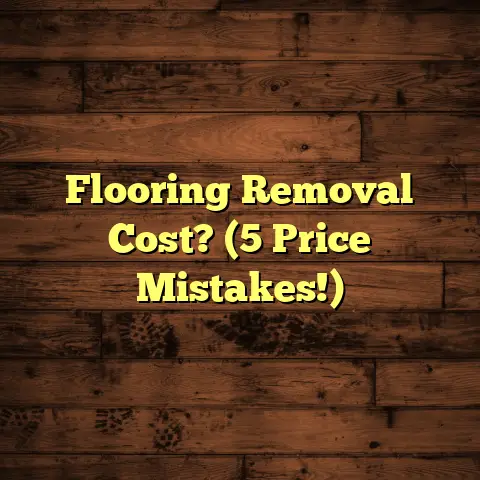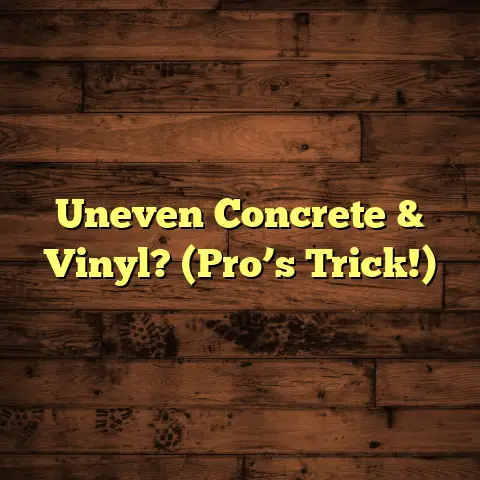Mold On Concrete: Is It Really Possible? (5 Signs)
Is It Really Possible? (5 Signs)
And let me tell you, I’ve seen things.
Renovations can be wild rides, filled with unexpected twists and turns.
I remember this one family, the Millers, who were so excited to remodel their basement.
They envisioned a cozy entertainment area, perfect for movie nights and game days.
But as they started tearing up the old carpet, they were hit with this musty, earthy smell.
Underneath, patches of black and green covered the concrete slab.
Mold. On concrete. Their faces just dropped.
It’s a moment I’ve witnessed more times than I’d like to admit.
The shock, the concern, the “how is this even possible?” look.
It’s a common misconception that concrete is impervious to mold.
But the truth is, mold on concrete is not only possible, it’s a legitimate concern.
Especially during renovations or in humid environments.
So, grab a cup of coffee, and let’s dive into this often-overlooked issue.
I’m going to break down the science behind mold growth on concrete.
And I’ll share the 5 telltale signs that should raise a red flag.
Trust me, knowing these signs could save you a lot of headaches (and money) down the road.
Section 1:
Understanding Mold
Okay, let’s start with the basics.
What exactly is mold?
In simple terms, mold is a type of fungus.
It thrives in damp environments and plays a crucial role in breaking down organic matter.
Think of it as nature’s recycler.
But while mold is essential in the great outdoors, it’s definitely not something you want growing inside your home.
There are thousands of different types of mold, but only a few are commonly found in residential settings.
Some of the usual suspects include:
-
Aspergillus: This is a very common type of mold and has over 185 species, with only a few causing health problems. Source: CDC
-
Cladosporium: Often found on plants, soil and decaying food, inside homes it can be found on fabrics and wood surfaces. Source: Science Direct
-
Penicillium: The source of the antibiotic penicillin, it’s also found in soil, decaying vegetation and air. Source: Science Direct
-
Stachybotrys chartarum: Often called “black mold,” is less common.
It’s associated with more serious health problems, although all mold exposure should be minimized.
Now, what conditions do these unwanted guests need to thrive?
Well, mold is kind of like that houseplant you forget to water.
Except, instead of water, it needs moisture, a suitable temperature, and organic material.
-
Moisture: This is the big one. Mold needs a source of water to grow.
That could be a leaky pipe, a damp basement, or even just high humidity.
-
Temperature: Mold generally prefers temperatures between 40°F and 100°F (4°C and 38°C).
Which, unfortunately, is the typical temperature range for most homes.
-
Organic Material: Mold feeds on organic matter, such as wood, paper, fabric, and even dust.
And that’s where concrete comes in.
While concrete itself isn’t organic, it can collect dust, dirt, and other organic residues over time.
These residues can then provide the food source that mold needs to grow.
“But wait,” you might be thinking, “isn’t concrete supposed to be, like, super durable and non-porous?”
That’s a fair question, and we’ll tackle it in the next section.
Section 2:
The Science Behind Mold Growth on Concrete
Alright, let’s get a little nerdy for a minute and talk about the science behind mold growth on concrete.
Yes, concrete is a strong and durable material.
But it’s not completely impervious to moisture.
Concrete is actually porous, meaning it has tiny pores or holes that allow water to seep through.
Think of a sponge.
It looks solid, but it’s full of tiny holes that can absorb water.
Concrete is similar, although the pores are much smaller.
This porosity is what allows moisture to penetrate the concrete and create a damp environment that mold loves.
But it’s not just the porosity of concrete that’s the issue.
Humidity also plays a significant role.
Even in seemingly dry environments, humidity levels can fluctuate, especially in basements or near sources of moisture.
According to the EPA, mold can start to grow when humidity levels exceed 60%.
And if you’ve ever lived in a humid climate, you know how quickly things can get damp and musty.
Now, let’s talk about those organic residues I mentioned earlier.
Dust, dirt, pollen, dead insects – these are all organic materials that can accumulate on concrete surfaces over time.
When these materials get wet, they become a food source for mold.
It’s like a buffet for these tiny organisms.
But don’t just take my word for it.
Numerous studies have shown that mold can colonize concrete under the right conditions.
For example, a study published in the journal “Construction and Building Materials” found that mold growth on concrete was significantly higher in environments with high humidity and the presence of organic matter.
This reinforces the idea that mold on concrete is not just a rare occurrence, but a legitimate concern that many homeowners face.
So, now that we’ve established that mold can grow on concrete, let’s talk about how to spot it.
Section 3:
5 Signs of Mold on Concrete
Okay, detective hat on!
It’s time to learn how to spot the telltale signs of mold on concrete.
Here are 5 things to look out for:
Sign 1: Visible Mold Growth
This one seems obvious, but it’s worth mentioning.
The most direct sign of mold on concrete is, well, seeing mold on concrete!
Mold can appear in a variety of colors and textures.
Some common colors include:
-
Black: Often associated with Stachybotrys chartarum (black mold).
-
Green: Can be Aspergillus or Penicillium.
-
White: May be powdery and resemble efflorescence (more on that later).
-
Brown: Can be various types of mold, depending on the specific species.
The texture can also vary.
Mold can be fuzzy, slimy, or even powdery.
It might appear as small, isolated spots or large, sprawling patches.
Pay close attention to areas that are prone to moisture, such as:
-
Corners and edges of the room
-
Areas near pipes or drains
-
Spots where water has leaked or spilled in the past
If you see any suspicious discoloration or growth on your concrete surfaces, it’s worth investigating further.
Sign 2: Musty Odors
Ever walked into a room and been hit with that distinctive musty smell?
That could be mold.
Mold spores release volatile organic compounds (VOCs) into the air, which are responsible for that characteristic odor.
Even if you can’t see any visible mold, a persistent musty smell can be a sign that mold is lurking somewhere nearby.
The intensity of the odor can vary depending on the amount of mold present and the ventilation in the area.
But if you notice a musty smell that doesn’t go away, it’s definitely worth investigating.
Sign 3: Water Stains and Efflorescence
Water stains and efflorescence are not mold themselves, but they can indicate moisture issues that may lead to mold growth.
Water stains are discoloration on the concrete surface caused by water seeping into the material.
They can appear as dark patches or streaks, and they often indicate a leak or moisture problem nearby.
Efflorescence, on the other hand, is a white, powdery residue that can appear on concrete surfaces.
It’s caused by mineral salts dissolving in water and then being deposited on the surface as the water evaporates.
While efflorescence itself is not mold, it indicates that moisture is present, which can create a favorable environment for mold growth.
If you see water stains or efflorescence on your concrete, it’s important to address the underlying moisture issue to prevent mold from growing.
Sign 4: Increased Allergy Symptoms
Mold can trigger allergies and respiratory issues in sensitive individuals.
If you or your family members have been experiencing increased allergy symptoms, such as:
-
Sneezing
-
Coughing
-
Runny nose
-
Watery eyes
-
Skin rashes
It could be a sign that mold is present in your home.
Mold spores can become airborne and inhaled, triggering an immune response in susceptible people.
The severity of the symptoms can vary depending on the individual’s sensitivity and the amount of mold present.
If you suspect that mold is contributing to your allergy symptoms, it’s important to consult with a doctor and have your home inspected for mold.
Sign 5: Peeling Paint or Crumbling Concrete
Mold can affect the integrity of concrete surfaces, leading to visible deterioration that homeowners might overlook.
If you notice that the paint on your concrete walls or floors is peeling or bubbling, it could be a sign that mold is growing underneath.
Mold can also weaken the concrete itself, causing it to crumble or crack.
This is because mold can break down the organic materials in the concrete, such as the cement paste that binds the aggregate together.
If you see any signs of deterioration on your concrete surfaces, it’s important to address the issue promptly to prevent further damage.
Alright, those are the 5 main signs to watch out for.
But remember, these are just indicators.
The only way to know for sure if you have mold is to have your home professionally inspected and tested.
Section 4:
Case Studies and Real-Life Examples
Let’s bring this all together with some real- life examples.
I’ve seen countless cases of homeowners who discovered mold on their concrete surfaces during renovations.
Take, for instance, the Johnsons.
They were renovating their basement to create a home office.
As they removed the old drywall, they found patches of black mold growing on the concrete foundation walls.
“We were shocked,” Mrs. Johnson told me.
“We had no idea that mold could grow on concrete. We always thought it was impermeable.”
They had to hire a professional mold remediation company to remove the mold and address the underlying moisture issue.
Then there was Mr. Davis, who noticed a persistent musty smell in his garage.
He couldn’t figure out where it was coming from until he started cleaning out some old boxes.
Underneath the boxes, he found a large patch of green mold growing on the concrete floor.
“I was disgusted,” he said.
“I thought my garage was clean, but I guess mold can grow anywhere if it’s damp enough.”
In both of these cases, the homeowners were unaware that mold could grow on concrete until they encountered it firsthand.
These stories highlight the importance of being vigilant and proactive when it comes to mold prevention.
It’s not enough to simply assume that your concrete surfaces are mold-proof.
You need to regularly inspect them for signs of moisture, musty odors, and visible growth.
And if you suspect that you have mold, don’t hesitate to call in the professionals.
Section 5:
Conclusion
So, let’s recap.
Can mold grow on concrete?
The answer is a resounding yes.
While concrete is a durable material, it’s not impervious to moisture.
And when moisture combines with organic matter, mold can thrive.
I hope this article has shed some light on this often-overlooked issue and empowered you to take action.
Remember, awareness is key.
By knowing the signs of mold on concrete, you can catch problems early and prevent them from escalating.
So, take a walk around your home today and inspect your concrete surfaces.
Look for visible growth, water stains, and other signs of moisture.
Sniff for musty odors.
And if you suspect that you have mold, don’t wait.
Call a professional mold inspector to assess the situation and recommend the appropriate course of action.
Your health and the health of your family are worth it.
Don’t let mold take hold and compromise your living space.
Take control, be proactive, and create a healthy, mold-free environment for yourself and your loved ones.
Thanks for joining me on this journey.
I hope this article has been helpful and informative.
Until next time, happy renovating!





